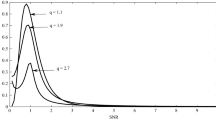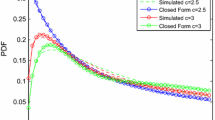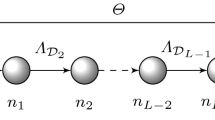Abstract
In wireless communication channels, the signals arriving at the receiver may be of stochastic nature or be superpositioned due to non-uniform scattering and shadowing. For the ease of computation, we generally assume the mean ergodic property of communication channels which is error prone. The well known lognormal model fails to capture the extreme tail fluctuations in the presence of shadowing. In this setting, we exploit the importance of Tsallis non-extensive parameter ‘q’ to characterize various fading channels. The q-lognormal distribution captures the tail phenomena due to presence of non-extensive parameter ‘q’. In this paper, we provide an excellent agreement between the generated synthetic signal and the proposed q-Lognormal distribution for different values of parameter ‘q’. This paper also presents the analytical expression for the superstatistics Weibull/q-lognormal model to capture both fading and shadowing effects. It is observed that the Weibull/q-Lognormal model provides a better fit to the generated signal for \(q=1.8\) in comparison to the well known Weibull/Lognormal model. Finally, we provide an excellent agreement between the derived measures viz., amount of fading, outage probability, average channel capacity with extensive Monte-Carlo simulation scheme.
Similar content being viewed by others
Avoid common mistakes on your manuscript.
1 Introduction
In realistic scenarios, the performance measures in wireless communication systems are strongly affected by multipath fading and shadowing effects [1,2,3] as the received signals may be of stochastic nature or be superpositioned. The shadowing effect in wireless communication is characterized through various distributions viz., Lognormal, Gamma and Inverse Gaussian [1, 3] whereas the multipath behavior is described using various models viz., Rician, Nakagami-m and Weibull distribution [1, 4]. These combined effects of fading and shadowing can be captured using composite fading/shadowed fading models and is portrayed well in the literature [5,6,7].
In wireless radio systems, the Weibull distribution has been proven to be of great importance towards capturing the effects of both indoor and outdoor fading phenomena [8, 9] in contrast to the available multipath fading models. The priority of the Weibull model in evaluating the performance measures of various communication systems have been portrayed in [10, 11]. However, it is pertinent to capture both the effects of fading and shadowing. These effects are portrayed by different mixture models viz., Rayleigh-Lognormal, Rician-Lognormal, Nakagami-Lognormal [1] and the Weibull-Lognormal (WL) distribution [12, 13]. The widely used lognormal distribution to characterize the shadowing effects however, fails to efficiently capture the tail fluctuations. In addition, the explicit solutions of these lognormal based mixture models are not analytically tractable and usually prone to errors under extreme fluctuations.
In this paper, we follow Beck-Cohen’s superstatistics framework [14], the superposition of two statistics that can characterize the composite shadowed fading channels. First statistics involves the Weibull distribution [1, 4] to describe fast fading channels. The second statistics i.e., the q-lognormal distribution is obtained by employing maximum Tsallis entropy framework [15,16,17,18] to characterize a wide range of slow fading channels for different values of the non-extensive parameter q. The dynamic range of non-extensive parameter ‘q’ characterizes the phenomenon of a variety of complex systems viz., physics, economics, bioinformatics, geography and communication systems [19]. The values of q mimics many existing well known models i.e., for \(q\rightarrow 1\), the q-lognormal model converges to the lognormal model and for \(q\rightarrow 1.5\), the q-Gaussian model captures the Student-t distribution with three degrees of freedom [15]. One important behavior (i.e., bimodality) of q-lognormal distribution is also observed for the value of \(q\ge 2.7\). The specific values of q (i.e., for \(q=1.4\) and \(q=1.5\)), the proposed model provides an excellent agreement with the generated synthetic data i.e., there is a proper balance between underfitting and overfitting.
The Tsallis entropy is maximized under the normalization constraint, first and second moment constraints of signal to noise ratio (SNR). The Lagrangian is constructed for the same and is further optimized using the Euler–Lagrange equation to obtain the proposed q-lognormal distribution. The unconditional proposed superstatistics Weibull/q-Lognormal model is obtained by conditioning the Weibull distribution over the q-lognormal distribution and is of fundamental significance due to the presence of non extensive parameter q over the mean ergodic behavior of communication channels. The parameter ‘q’ in the proposed model can capture the entire range of tail fluctuations for \(1<q<3\). Hence, it is worthwhile to characterize the wide range of wireless communication channels and correlated fading phenomena using the superstatistics Weibull/q-Lognormal model.
The closed form solution for the probability density function (PDF) corresponding to SNR is evaluated by using Holtzman technique [20]. The performance measures viz., amount of fading and outage probability are approximated and the analytical solution for these measures has been obtained. In conjunction to this, an important performance metric i.e., the average channel capacity is approximated using Meijer’s G-function in terms of Fox’s H representation [21]. Furthermore, the obtained measures are also validated through extensive Monte-Carlo simulation schemes, and since the error complexity of Monte-Carlo simulation is \(O\left( {{N^{ - 1/2}}} \right)\), to get an accurate and tight result, we average over \(O(10^8)\) simulation paths.
The rest of the paper proceeds as follows. In Sect. 2, we derive the q-Lognormal PDF using maximum Tsallis entropy framework to characterize slow fading channels. The significance of the q-Lognormal distribution is portrayed in Sect. 3. In Sect. 4, the analytical model for the generalized superstatistics Weibull/q-Lognormal is computed. The next Sect. 5, outlines the various performance metrics of the composite fading channel viz., the amount of fading, average channel capacity, outage probability (\(P_{out}\)) and the results are validated using Monte–Carlo simulation scheme. Finally, we conclude this paper in Sect. 6.
2 The q-Lognormal Distribution
In this section, the analytical expression for the non-extensive q-Lognormal pdf is derived. Let Z denote the random variable of the received average SNR (z) i.e.,
The Tsallis entropy [15, 16] in terms of the parameter q is given by
The constant of normalization is given as
The first and second moment of SNR are defined as
and
where
is defined as the escort probability distribution [22, 23]. The uses of the escort probability distribution over the general probability distribution is described in [22]. The Lagrangian is constructed and is given by
where \({\lambda _1}\), \({\lambda _2}\) and \({\lambda _3}\) are Lagrangian multipliers. Using Euler–Lagrange equation:
Equation 8 together with Eqs. 1 to 7, provides the maximum entropy q-Lognormal PDF for slow fading channels as:
where C is the normalization constant and is given by
When \(q\rightarrow 1\), Eq. 9 exhibits the Lognormal model given as
3 Significance of the q-Lognormal Distribution
This section describes the impact of the proposed q-Lognormal distribution in characterizing the effects of the shadowing effects over the well known lognormal distribution. It is well known that all the slow fading channels are characterized by lognormal distribution [1, 12, 24]. However, this assumption fails to capture the outliers in the fading signal. So, in this context, we provide a new entropy based approach to capture the tail fluctuations observed in slow fading channels. The q-Lognormal model converges to lognormal distribution as \(q\rightarrow\)1. Fig. 1, illustrates the PDFs correspoding to the Lognormal and q-Lognormal distribution when q → 1. In Fig. 2, we provide the q-Lognormal PDF for different values of non-extensive parameter q, when q = 1.1, q = 1.9, and q = 2.7. But, for \(q=1\) the model cannot characterize the tail fluctuations as shown in Fig. 3. However, the parameter ‘q’ in the proposed model can capture the entire range of tail fluctuations for \(1<q<3\). The synthetic signal generated using MATLAB is well characterized by the proposed q-Lognormal model for \(q=1.4\) and \(q=1.5\) as shown in Figs. 4 and 5.
4 Analytical Model
In wireless communication systems, it is observed that the Weibull distribution provides an envelope for multipath fading channels whereas the generalized q-Lognormal model can characterize the shadowing effects. In this context, we derive an analytical expression for the generalized superstatistics Weibull/q-Lognormal model to capture the simultaneous effects of both fading and shadowing phenomena.
The conditional Weibull distribution is defined as [1, 25],
where z is the received average signal to noise ratio (SNR), \(\gamma\) is the received SNR, \(A = {\left[ {\varGamma \left( {1 + \frac{2}{\beta }} \right) } \right] ^{\beta /2}}\) and \(\varGamma (.)\) represents the Gamma function. The channel condition improves as the multipath/fading parameter \(\beta \rightarrow \infty .\)
4.1 Superstatistics Weibull/q-Lognormal Model
The superstatistics distribution is obtained by superimposing the Weibull distribution and the q-Lognormal distribution. The Weibull distribution is defined in Eq. 12 whereas the PDF of a q-Lognormal distribution is defined in Eq. 9.
The composite distribution can be defined as [5]:
Using Eq. 13 along with Eqs. 12 and 9, we have:
For \(q\rightarrow 1\) Eq. 14 reduces to:
Now substituting \(\ln (z) = t\), we have:
Applying Holtzman Three Point Distribution [20], we obtain the generalized superstatistics Weibull/q-Lognormal PDF as follows:
where
Figure 6 shows the plot of the analytical and simulation results of the Weibull/q-lognormal model. In Fig. 7 it can be seen that the well known Weibull/lognormal model [12, 13, 26] does not provide a good fit with the generated synthetic signal. The synthetic signal has been generated using MATLAB. However, in Fig. 8 it is seen that the Weibull/q-Lognormal model provides an excellent agreement with the generated synthetic signal for the value of the non extensive parameter \(q=1.8\). The plots in Figs. 7 and 8 are obtained by using Monte-carlo simulation technique on Eq. 14.
5 Performance Analysis
In this section, the various performance metrics viz., amount of fading, outage probability and average channel capacity for the superstatistics shadowed fading model are evaluated and the analytical expressions for each measures have been presented.
5.1 Amount of Fading
An important and condemnatory performance measure in fading environment is the Amount of Fading that specifies the severity of fading. It is mathematically expressed as [26]:
The closed form expression obtained in Eq. 17 is the sum of three Weibull distributions terms and the kth moment of \(\gamma\) (SNR per symbol) is obtained as:
Substituting \(\bar{\gamma } = \exp (t)\), we obtain:
Using Eq. 21 equipped with Eq. 17, we have:
Finally, the analytical expression for Amount of Fading is given as:
We present the analytical and simulation results for amount of fading in Fig. 9, for σ = 6 dB, σ = 4 dB, and σ = 2 dB.
5.2 Average Channel Capacity
The channel capacity is defined as the maximum transmission capacity that a channel is capable of achieving with a small probability of error [27]. It is significant to study the channel capacity in fading environments and hence we exploit the Meijer’s G function to derive the analytical expression of the average channel capacity.
The ergodic channel capacity is defined as [28]:
where B represents bandwidth of the fading channel. Using Eqs. 17, 24 we have:
Using Meijer’s G-functions [29] and modifying the above equations according to \(\ln (1 + x) = \mathop G\nolimits _{22}^{12} \left[ {x\left| {_{1,0}^{1,1}} \right. } \right]\) and \(\exp ( - x) = \mathop G\nolimits _{01}^{10} \left[ {x\left| {_0^.} \right. } \right]\) we obtain:
From Eq. 26 and using the substitutions given in [21] we obtain:
Thus, from Eqs. 17 and 27, the average channel capacity can be expressed in closed form as:
where \({q_1}=2/3, {q_2}={q_3}=1/6,\) and \({p_k}=\frac{{\varGamma (1 + 2/\beta )}}{{\exp ({t_k})}}\) with \({t_1}=\mu , {t_2}=\mu + \sqrt{3} \sigma\) and \({t_3}=\mu - \sqrt{3} \sigma\). In Fig. 10, the analytical and simulation results corresponding to the average channel capacity for different values of β i.e., β = 2, β = 2.5, and β = 3.
5.3 Outage Probability
For wireless communications systems functioning over fading channels the outage probability stands as an important performance measurement. It is denoted by \(P_{out}\) and is stated as the probability of the output SNR \(\gamma\), not exceeding a specified threshold value \(\gamma _{th}\) .
It is expressed mathematically as [1]:
From Eqs. 17, 18, 29 and using [30] Eqs. (3.381.1) and (8.352.1) the analytical expression for outage probability is obtained as follows:
Through Fig. 11, we provide the analytical and simulation results of the outage probability (Pout) versus threshold SNR for different values of β, viz., β = 1, β = 3, and β = 5.
6 Conclusion and Future Work
In this paper, various performance measures viz., SNR, amount of fading, outage probability and average channel capacity over the superstatistics Weibull/q-Lognormal model were expressed in closed form. As \(q \rightarrow 1\), this generalized superstatistics model provided an excellent agreement with the results of [26]. The model characterized the fast fading as well as shadowing effects of various wireless communication channels for different values of the non extensive parameter q. It has been observed that the Weibull/q-Lognormal model provided a better agreement to the generated signal for \(q=1.8\) in comparison to the well known Weibull/Lognormal model. The analytical expressions of the aforementioned performance metrics were obtained using Holtzman technique and Meijer’s G function equipped with Fox’s (H) function. Furthermore, the results were validated using extensive Monte-carlo simulation techniques.
Since, the proposed Weibull/q-Lognormal model is not analytically tractable, we follow rigorous simulation technique to validate our results. Thus, it will be an interesting and challenging task to obtain the closed form expression for the same and derive the performance measures which will be the future objective of this work.
References
Simon, M. K., & Alouini, M. S. (2005). Digital communication over fading channels (Vol. 95). Hoboken: Wiley.
Shankar, P. M. (2017). Fading and shadowing in wireless systems. Berlin: Springer.
Rappaport, T. S. (1996). Wireless communications: Principles and practice (Vol. 2). Upper Saddle River: Prentice Hall PTR.
Sagias, N. C., & Karagiannidis, G. K. (2005). Gaussian class multivariate Weibull distributions: Theory and applications in fading channels. IEEE Transactions on Information Theory, 51(10), 3608–3619.
Shankar, P. M. (2004). Error rates in generalized shadowed fading channels. Wireless Personal Communications, 28(3), 233–238.
Bithas, P. S., Sagias, N. C., Mathiopoulos, P. T., Karagiannidis, G. K., & Rontogiannis, A. A. (2006). On the performance analysis of digital communications over generalized-K fading channels. IEEE Communications Letters, 10(5), 353–355.
Laourine, A., Alouini, M. S., Affes, S., & Stphenne, A. (2009). On the performance analysis of composite multipath/shadowing channels using the G-distribution. IEEE Transactions on Communications, 57(4), 1162–1170.
Hashemi, H. (1993). The indoor radio propagation channel. Proceedings of the IEEE, 81(7), 943–968.
Adawi, N. S. (1988). Coverage prediction for cellular mobile radio system operating in the 800/900 MHz frequency band. IEEE Transaction on Vehicular Technology, 37(1), 3–72.
Sagias, N. C., Zogas, D. A., Karagiannidis, G. K., & Tombras, G. S. (2004). Channel capacity and second-order statistics in Weibull fading. IEEE Communications Letters, 8(6), 377–379.
El Bouanani, F., Ben-Azza, H., & Belkasmi, M. (2012). New results for Shannon capacity over generalized multipath fading channels with MRC diversity. EURASIP Journal on Wireless Communications and Networking, 2012(1), 336.
Karadimas, P., & Kotsopoulos, S. A. (2009). The Weibulllognormal fading channel: Analysis, simulation, and validation. IEEE Transactions on Vehicular Technology, 58(7), 3808–3813.
Singh, R., Soni, S. K., Raw, R. S., & Kumar, S. (2017). A new approximate closed-form distribution and performance analysis of a composite Weibull/log-normal fading channel. Wireless Personal Communications, 92(3), 883–900.
Beck, C., & Cohen, E. G. D. (2003). Superstatistics. Physica A: Statistical Mechanics and its Applications, 322, 267–275.
Senapati, D. (2016). Generation of cubic power-law for high frequency intra-day returns: Maximum Tsallis entropy framework. Digital Signal Processing, 48, 276–284.
Tsallis, C. (2004). Nonextensive statistical mechanics: construction and physical interpretation. Nonextensive Entropy, Interdisciplinary Applications, 1–53.
Singh, A. K., & Singh, H. P. (2015). Analysis of finite buffer queue: maximum entropy probability distribution with shifted fractional geometric and arithmetic means. IEEE Communications Letters, 19(2), 163–166.
Rajput, N. K., Ahuja, B., & Riyal, M. K. (2018). A novel approach towards deriving vocabulary quotient. Digital Scholarship in the Humanities, 33(4), 894–901.
Picoli, S, Jr., Mendes, R. S., Malacarne, L. C., & Santos, R. P. B. (2009). q-distributions in complex systems: A brief review. Brazilian Journal of Physics, 39(2A), 468–474.
Holtzman, J. M. (1992). A simple, accurate method to calculate spread-spectrum multiple-access error probabilities. IEEE Transactions on Communications, 40(3), 461–464.
Mathai, A. M., & Haubold, H. J. (2008). Special functions for applied scientists (Vol. 4). New York: Springer.
Abe, S., & Bagci, G. B. (2005). Necessity of q-expectation value in nonextensive statistical mechanics. Physical Review E, 71(1), 016139.
Namaki, A., Lai, Z. K., Jafari, G. R., Raei, R., & Tehrani, R. (2013). Comparing emerging and mature markets during times of crises: A non-extensive statistical approach. Physica A: Statistical Mechanics and its Applications, 392(14), 3039–3044.
Shankar, P. M. (2011). Statistical models for fading and shadowed fading channels in wireless systems: A pedagogical perspective. Wireless Personal Communications, 60(2), 191–213.
Lieblein, J. (1955). On moments of order statistics from the Weibull distribution. The Annals of Mathematical Statistics, 1, 330–333.
Chauhan, P. S., Tiwari, D., & Soni, S. K. (2017). New analytical expressions for the performance metrics of wireless communication system over Weibull/Lognormal composite fading. AEU-International Journal of Electronics and Communications, 82, 397–405.
Shannon, C. E. (2001). A mathematical theory of communication. ACM SIGMOBILE Mobile Computing and Communications Review, 5(1), 3–55.
Tiwari, D., Soni, S., & Chauhan, P. S. (2017). A new closed-form expressions of channel capacity with MRC, EGC and SC over lognormal fading channel. Wireless Personal Communications, 97(3), 4183–4197.
Adamchik, V. S., & Marichev, O. I. (1990, July). The algorithm for calculating integrals of hypergeometric type functions and its realization in REDUCE system. In Proceedings of the international symposium on Symbolic and algebraic computation(pp. 212–224). ACM.
Gradshteyn, I. S., & Ryzhik, I. M. (2014). Table of integrals, series, and products. New York: Academic press.
Author information
Authors and Affiliations
Corresponding author
Additional information
Publisher's Note
Springer Nature remains neutral with regard to jurisdictional claims in published maps and institutional affiliations.
Rights and permissions
About this article
Cite this article
Mukherjee, T., Singh, A.K. & Senapati, D. Performance Evaluation of Wireless Communication Systems over Weibull/q-Lognormal Shadowed Fading Using Tsallis’ Entropy Framework. Wireless Pers Commun 106, 789–803 (2019). https://doi.org/10.1007/s11277-019-06190-8
Published:
Issue Date:
DOI: https://doi.org/10.1007/s11277-019-06190-8















